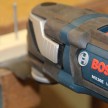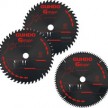Framing and Demo Saw Blade Comparison Testing
Saw Blade Showdown: A Test of Speed, Durability, and Performance
When it comes to framing and demolition, choosing the right saw blade can make all the difference between a job well done and one that drags on longer than necessary. Framing blades, with their standard 24-tooth design, are built to tackle the fast-paced, high-demand world of construction—where speed trumps perfection.
But what happens when we push these blades to their limits? In this head-to-head test, we put seven 7-1/4” framing and demo saw blades through a rigorous series of challenges to see how they stack up in terms of cutting speed, longevity, and resistance to wear.
From clean wood cuts to nail-embedded tests designed to accelerate blade wear, we dive into the performance of each blade to find out which one truly offers the best “speed-to-life” balance. Whether you’re framing a house or tearing through demo work, this guide will help you make an informed decision about which blade delivers the best value for your hard-earned dollars.
“Speed to life” in this context refers to the relationship between the saw blade’s speed (measured in surface feet per minute, SFPM) and its blade life.
Blades Tested | Specifications
We tested 7 common, 24-tooth framing blades, they were:
7-1/4” Framing Blade
24 Teeth
Model # CSBFR-724
7-1/4” Framing blade
24 Teeth
Model # DWAW71424
Diablo Demo Demon
7-1/4” Ultimate Framing
24 Teeth
Model # D0724D
Irwin Marathon
7-1/4” Framing blade
24 Teeth
Model # NA144317
Makita MAX Efficiency
7-1/4” Framing blade
24 Teeth
Model # B-61656
Milwaukee NITRUS Carbide
7-1/4” Framing | Demolition blade
24 Teeth
Model # 48-40-0750
Spyder Tarantula
7-1/4” Carbide tipped saw blade
NiCo (nickel cobalt)
24 Teeth.
Factors That Wear Saw Blades
The speed at which a circular saw blade can cut through a material is influenced by several factors:
Blade Features (width, diameter, tooth count, and tooth shape)
- Blade rotational speed
- Horizontal force applied
- Material cut
Experienced saw users, often adjust our cutting speed based on the sound of the saw blade and motor. If the saw is straining, we’ll slow down; if not, we might speed up.
Saw Blade Performance Tests
We conducted three primary tests and an additional test for the top performers.:
- Clean Wood Baseline Test – baseline cut in clean wood for time.
- Nail Embedded Cut Test – to accelerate blade wear
- Clean Wood Used Blade Test -We used the blade that just completed the nail-embedded test, to compare cutting performance from its initial clean wood baseline test.
- Sawpocalypse Test – For the blades that showed any sign of life after the above three tests we ran them through the nail-embedded test a second time.
Circular Saw and Battery Variables
For our testing saw, we chose the Makita 40V XGT rear-handle 7-¼” circular saw to test these blades.
Makita 40V Cordless saw runs at 6400 rpm. With the wide range of speed and power available from the saws on the market, end-users should expect see different results from the different cordless platforms and models.
Makita Saw Specs
- Blade Diameter : 7-1/4″
- No Load Speed : 6,400 RPM
- Max. Cutting Capacity (at 90°) : 2-9/16″
- Max. Cutting Capacity (at 45°) : 1-3/4″
- Max. Cutting Capacity (at 53°) : 1-1/2″
- Arbor : 5/8″
- Net Weight (with battery) : 11.7 lbs.
- Battery : 40V max XGT® Lithium-Ion
- Overall Length : 17-1/2″
- Motor Type : Brushless
A fully charged, ambient temperature battery was used in the saw for each test. After each test cut, the saw was allowed to rest for 5 minutes and cooled using compressed air through the vent slots. No electronic or battery overload issues occurred during testing.
Controlling Cutting Variables | Saw Cutting Sled
To produce repeatable results we used a Kreg Accu-Cut track system, with a drop-weight pulley system providing a consistent 11 lb. horizontal force to pull the saw through the cut.
We chose the 11 lb. weight because it closely matched our pro users cutting speed in clean wood. After each test, the sled and track were cleaned of sawdust and lubricated with silicone spray to ensure smooth operation.
Controlling Timing Variables
Electro-mechanical switches were secured to the start and stop sections of the cutting rig. The time automatically started as the saw began its cut and automatically stopped as the sled reached the far end, as the cut finished.
The timer had an upper limit stop at 100-seconds.
NEW Blade | Clean Wood Baseline Cut Test
We needed to establish a baseline for each new blade by cutting through 104-inches clean kiln-dried wood. This time recorded would then be used to compare to the same blade after having gone through the nail embedded wood cutting test.
Designed for speed, It was wild to see the Makita MAX blade crush the competition in clean wood with a scorching time of 6.65 seconds. The Makita cut more than twice as fast as the next closest blade. Diablo Demo Demon was 13.86 seconds and Spyder Tarantula was 14.7 seconds
Nail-Embedded Cut Test
To accelerate wear and tear, we designed a challenging 104-inch long nail-embedded cutting test. This torture test was designed to quickly degrade the saw blade.
The material used was a 2×10 KD lumber with 16-penny framing nails, pre-drilled, and embedded every inch. [total 94 nails]
If a saw blade was unable to complete the full cut before our allotted 100-seconds, or safety became a concern. The saw was manually stopped, and the number of nails cut was noted.
Several blades from each manufacturer were tested in the rig and an average time was used.
Nail-Embedded Cut Test Results
We scored the results based on “nails cut” and “time cut.”
The Milwaukee Nitrus blade was a clear standout, cutting through the entire 94 nails in 47-seconds, which was twice as fast as the rest of the blades. [That’s an amazing 2 nails per second]
Second was Spyder Tarantula which was also able to cut the entire 94 nails in 90 seconds. Makita MAX timed out at 100-seconds cutting 92 nails.
Clean Wood Used-Blade Cut Test
Following the nail-embedded cuts, we tested how quickly the previously “used” blade could cut through clean wood. This demonstrated the impact of previous wear from the nail-embedded test.
The reason for this test is to show speed-to-life as Pro users want to know that their saw blade is still usable after a nail strike.
The percent increase in time to cut was calculated for each blade. This shows the relative wear on an individual blade after the nail-embedded test. A lower percentage increase should indicate less destructive wear on the blade teeth and indicate more usable life. This statistic can be a bit skewed for the slower cutting blades like the Irwin and Crescent.
Clean Wood Used-Blade Test Results
The Milwaukee Nitrus blade delivered surprisingly good results, not only maintaining its cutting speed but a\lso slightly improving the time to 20.37 seconds. This small decrease in time was likely due to wood variability.
The next closest blade was the Diablo Demo Demon, with a time of 36.36 seconds—an increase of 162% from its baseline test time of 13.86 seconds.
In third place was the Makita MAX, with a time of 49.63 seconds, but it showed significant blade wear, with a 646% increase from its baseline time.
An interesting observation was that both the Dewalt Elite and Spyder Tarantula blades couldn’t complete the clean wood test. The Spyder, however, was the only other blade that managed to cut through all 94 nails in under 100 seconds. The fact that it couldn’t finish the clean wood test indicates that it had reached the end of its lifespan just at the end of the nail-embedded test.
Sawpocalypse Test
At the end of our initial nail-embedded test, three blades — Diablo, Makita, and Milwaukee — still showed impressive speed and life. We decided to run these blades through the test a second time to push their limits.
The Milwaukee Nitrus completed the entire test, cutting 94 nails in 80 seconds. Although it’s time increased from 47 seconds in the first run, it still outperformed all other blades times and nails cut on their initial runs.
Second place went to the Diablo Demo Demon, cutting 73 nails in 100 seconds. The Makita MAX took third, cutting 28 nails before timing out at 100 seconds.
Field Testing the Saw Blades
Over several weeks, we tested a variety of blades in the field and evaluated their performance based on the following factors:
- Speed
- Tracking
- Speed-to-Life (the vibration and performance shift that signals when it’s time to change the blade)
Since these blades were primarily used for framing and demo work in remodeling and framing applications, I didn’t focus on the quality of the cut itself, but rather on the overall performance under typical field conditions.
Here are some notable observations:
Nitrus Blade in Action
While cutting through White Oak flooring, I used the Nitrus blade. During one of the cuts, the blade struck an angled flooring cleat nail. Although the blade managed to defeat the nail and kept all of its teeth intact, the subsequent cutting performance was noticeably slower than before the strike.
In my experience, these sharp angled, hardened steel flooring cleat nails are among the most damaging obstacles a saw blade can face. I attempted to use the same blade later for cutting 2×12 PT stringers, the cut rate was significantly slower than acceptable, requiring more feed pressure on the blade, so I elected to replace it.
We did note that the Milwaukee blade has a slightly slower feed rate than some of the other blades.
Diablo Blade Performance
The Diablo blade cuts fast. For cutting pressure-treated (PT) stringers and executing compound bevel cuts in 2×12 PT, the Diablo blade was the top performer, offering excellent cutting speed and tracking accuracy.
Makita Blade Performance
In 90-degree cross-cutting of lumber, the Makita blade delivered the fastest cutting speed among all tested blades. However, despite its speed, it exhibited mediocre tracking during compound bevel cuts in 2×12 PT framing material.
Spyder Blade Performance
The Spyder blade also cuts fast, and performed well when cutting framing lumber and PT stringers, maintaining good tracking during compound bevel cuts.
DeWalt Blade Performance
The DeWalt blade also demonstrated strong performance in cutting framing lumber and PT stringers, with solid tracking on compound bevel cuts.
Crescent and Irwin Blade Performance
Both Crescent and Irwin blades cut effectively but were noticeably slower when cutting framing lumber and PT stringers. Additionally, minor tracking issues were observed during compound bevel cuts.
Price Considerations
As with any consumable accessory, price is always a factor. When evaluating saw blades, it’s important to remember that all of them will eventually face wear and tear.
On one hand, we have the Milwaukee blade, which performs exceptionally well but comes with a price tag more than 2.5 times higher than the least expensive options.
So, the question remains: Is it worth the price?
Are the higher-cost, higher-performing blades worth the investment, or do the more affordable options deliver enough performance to justify their lower cost?
If you’re a remodeler and you’re cutting onto existing houses, floors and roofs I’d say the answer is obvious. Its Nitrus!
For those interested in making a purchase, Ohio Power Tool carries many of these blades. We’ll be sure to include some purchase links in the video description for easy access!
OPT Purchase Links
Conclusion
As a remodeling contractor, investing in a longer-lasting blade ultimately saves both time and money. However, there’s always a balance between performance and price, and that balance varies for each user.
The Milwaukee Nitrus blade emerged as the highest-performing blade in terms of durability during our nail-embedded cut test. However, it’s also by far the most expensive option.
Let’s be real: no one’s going to hit 94 nails in a single day, but this test was designed to accelerate wear, and give you an understanding of what this blade can do. While Milwaukee might not be the fastest blade on clean wood, it excels at holding its cutting performance over time, especially in tough conditions.
In my opinion, most professional users—including myself—will lean toward the faster-cutting, more affordable blades like the Diablo Demo Demon for standard cutting operations.
As a remodeler who often cuts through hardwood flooring, subfloors, and roof sheathing—materials that frequently have embedded nails—I’m excited to now have the Milwaukee Nitrus blade as an option. It’s built to handle those tough challenges and keep performing without issue.
For situations like these, I’ll definitely have a Nitrus blade (or two) on standby in my van.
Clearly, Milwaukee has made some impressive engineering decisions to create a juggernaut of a saw blade that can stand up to nail strikes without backing down.
Framing | Demo Blade Comparison Video Review

































